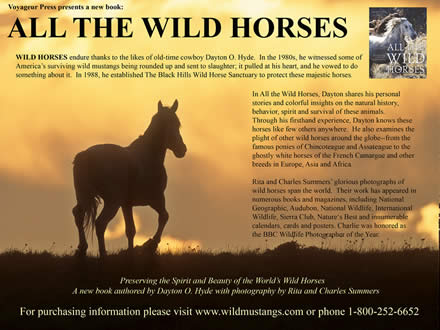Wild Horses and Wild Images...
In the late 1980's, a rancher friend took me (Rita) on a day long ride, on dirt roads or no roads at all, through remote areas on the Wyoming/Colorado border to see wild horses. I was hooked immediately. Every summer and fall I would spend weeks at a time driving around, hoping the wild horses would get used to seeing my VW camper, and would allow me close enough to get a few photos. Gradually I collected enough photographs to propose a calendar to Tide-Mark Press. As a result of this first wild horse calendar, published in 1994, Charlie and I concentrated on wild horses and traveled all over the West to see and photograph them. The publisher asked me to select an organization to receive benefits from the calendar. I had heard good things about Dayton Hyde and the facility he was establishing in South Dakota for unadoptable wild horses so I selected the Black Hills Wild Horse Sanctuary (www.wildmustangs.com). We hadn't visited the sanctuary at that time but have been there many times since then and have enjoyed knowing this remarkable man and seeing the horses run free.
A book about wild horses?
The wild horse book itself is a coffee table book with outstanding writing, actually spellbinding writing, by Dayton about the equine family, how they got here, where they came from, how the mustang came to be and where the wild horse stands today. It also covers zebra with factual information on their behavior and habitat, the Somali Wild Ass, a member of the horse family from which all donkeys are descended, the wild ponies of England including the Exmore and Dartmore ponies, the Camargue horse of France and the Przewalski wild horse, the only truly wild horse left in the world.
Our mission with photographing the wild horse was to portray as best we could one of the remnants of the old west. It gave us a tremendous gratification knowing that some of the proceeds of the calendar went towards helping unadoptable wild horses live out their lives in peace in a semi wild environment. In our pursuit of the wild horse, we have traveled Oregon, Idaho, Montana, Wyoming, Colorado, Utah and Nevada in the west and Maryland, Virginia and North Carolina in this country. Our travels to photograph wild horses have taken us to Europe and Africa as well.
There is something magical about seeing the wind rush through the long, sometimes tangled mane of a wild horse or hearing the hoofbeats as they thunder by, seeing their tenderness with new born colt or the aggressive behavior of a herd stallion guarding his harem. There is also something sad about seeing such a majestic animal in the wild knowing that they live under the harshest of circumstances, that they must learn to run on uneven ground where the danger of a burrow or rock to trip over waits, or forage through deep snow as exposed ribs attest. There is nothing romantic about being a wild horse but there is romanticism in seeing this animal in the wild, running free.
"As long as wild horses are galloping free
I'll dream of the west as I want it to be"
Rita Summers




